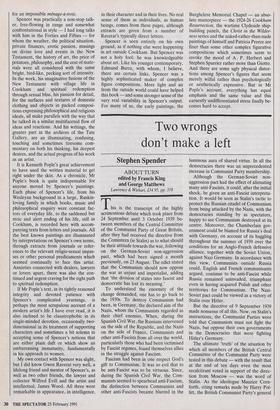The view from Cookham
Bryan Robertson
STANLEY SPENCER: A BIOGRAPHY by Kenneth Pople
Collins, £25, pp. 576
The life and work of Stanley Spencer, who died in 1959, must have served as an almost irresistible example for Joyce Carey or Patrick White and any other novelists drawn to the eccentricities of an artist's 'visionary' life as the subject for a picares- que novel. But Spencer's real life and work were so peculiar, both in themselves and in their unusually tight interdependence, that no novelist could have added anything without a kind of spiritual betrayal — in the sense that certain pieces of music are already so eloquent that no serious choreographer will touch them as a subject for dance, the music says everything that could possibly be said.
But it is Spencer's paintings and draw- ings, with his incessant writings, his letters and journals — initially embarked upon as a commissioned autobiography which, in prolixity and diffuseness, frightened pub- lishers into retreat — that provide us with the true, complex imaginative density, rather than the actually recorded day-to-day de- tails of the life itself. It was the way in which Spencer habitually thought, his inner life, and the angle from which he viewed daily events that combined with his paintings to make such an extraordinary whole. Spencer's practical life as a hard-working painter, continuously at work in his birth- place, Cookham, was comparatively mun- dane, disrupted only by his 1914-18 war experiences on active service with a Field Ambulance in Macedonia, and the later, obsessively prolonged, infatuation with a cold and greedy woman, herself living with another woman, for whom he separated from his adored first wife, Hilda, hoping for an impossible ménage-d-trois.
Spencer was practically a non-stop talk- er, free-flowing in range and somewhat confrontational in style — I had long talks with him in the Forties and Fifties — for whom the weather, the political situation, private finances, erotic passion, musings on divine love and events in the New Testament, the history of art, the price of potatoes, philosophy, and the cost of mate- rials were all considered with the same bright, bird-like, pecking sort of intensity. In the work, his imaginative fusions of the New Testament with village life in Cookham and spiritual redemption through sexual bliss, his passion for detail, for the surfaces and textures of domestic clothing and objects in packed composi- tions expressing philosophical and religious ideals, all make parallels with the way that he talked in a similar multifaceted flow of ideas and reactions. And his writings, the greater part in the archives of the Tate Gallery, are an illuminating, confusing, touching and sometimes tiresome com- mentary on both his thinking, his deepest desires, and the actual progress of his work as an artist.
It is Kenneth Pople's great achievement to have used the written material to get right under the skin. As a chronicle, Mr Pople's book is quite indispensable for anyone moved by Spencer's paintings. Each phase of Spencer's life, from his Wesleyan background in a large, Ruskin- loving family in which books, music and philosophical enquiry were constant fac- tors of everyday life, to the saddened but stoic and alert ending of his life, still in Cookham, is recorded here with accom- panying texts from letters and journals. All the best known paintings are illuminated by interpretations on Spencer's own terms, through extracts from journals or refer- ences to the relevant religio-sexual impas- ses or other personal predicaments which seemed continually to face this artist. Anxieties connected with dealers, lawyers or lovers apart, there was also the con- tinued and urgent craving for the right path to spiritual redemption.
If Mr Pople's text, in its tightly reasoned integrity and devoted patience with Spencer's complicated yearnings, is perhaps the most scrupulous account of a modern artist's life I have ever read, it is also inclined to be claustrophobic in its single-minded devotion, occasionally two- dimensional in its treatment of supporting characters and sometimes a bit solemn in accepting some of Spencer's notions that are either plain daft or which show an embarrassing immaturity, fundamentally in his approach to women.
My own contact with Spencer was slight, but I did know Gwen Raverat very well, a lifelong friend and mentor of Spencer's, as well as two other friends, the lawyer and collector Wilfred Evil and the artist and intellectual, James Wood. All three were remarkable in appearance, in intelligence, in their character and in their lives. No real sense of them as individuals, as human beings, comes from these pages, although extracts are given from a number of Raverat's typically direct letters.
Spencer is seen entirely on his own ground, as if nothing else were happening in art outside Cookham. But Spencer was not a holy fool: he was knowledgeable about art. Like his younger contemporary, Edmund Burra, with whom, I believe, there are certain links, Spencer was a highly sophisticated maker of complex figure compositions. More light and air from the outside world could have helped this book — and some stronger sense of the very real variability in Spencer's output. For many of us, the early paintings, the Burghclere Memorial Chapel — an abso- lute masterpiece — the 1924-26 Cookham Resurrection, the wartime Clydeside ship- building panels, the Christ in the Wilder- ness series and the naked-rather-than-nude paintings of himself and Patricia Preece are finer than some other complex figurative compositions which sometimes seem to invoke the mood of A. P. Herbert and Stephen Spurrier rather more than Giotto. And there are some ugly physical distor- tions among Spencer's figures that seem merely wilful rather than psychologically or aesthetically expressive. But in Mr Pople's account, everything has equal emphasis and the same value and this earnestly undifferentiated stress finally be- comes hard to accept.



















































 Previous page
Previous page